New York reviews unabridged

film
Ordinary People
06.05.09
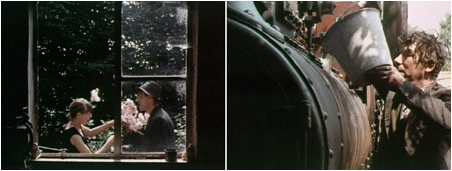
Philip Trevelyan, The Moon and the Sledgehammer, 1971, stills from a color film, 65 minutes. Left: Kathy Page and Jim Page. Right: Pete Page.
An obscure gem—or prize scrap—from the golden age of cinema verité, Philip Trevelyan’s 1971 documentary The Moon and the Sledgehammer goes down a rabbit hole and comes up face-to-face with one of the most bizarre and captivating families ever filmed. The Page clan lives without electricity or running water, on a six-acre woodland plot outside London that’s littered with ancient machine parts. They hunt forest creatures and otherwise get by on what the two grown sons earn fixing ancient steam engines.
The sons, Peter and Jim, work in grubby suits and collars. Peter (who believes his country should run on steam because “there’s no oil wells in England”) has an edge, while Jim’s a cheerful dreamer: “You are my garden of roses / Kissed by the morning dew,” he warbles, as his sister Kath cuts flowers. And he claims to know a thing or two about the stars, having viewed them through a telescope he made from “ordinary, usual bits of stuff that you would find in a scrap yard.”
Trevelyan (son of Julian Trevelyan, the painter) delves into this tumbledown time capsule with enthusiasm, filming nature—human specimens, mainly—in microscopic detail. While airplanes roar overhead, the Pages are down in the sawdust with beetles, spiders, and their pet peacock. With the exception of Kath (the more outgoing of the two sisters) and Jim, the family doesn’t seem to get along particularly well; Trevelyan tends to film them separately, and almost everything they say is directed outside the frame.
Mr. Page, the aging patriarch, wanders about in a trilby and grease-stained trench coat. He’s got a bit of Lewis Carroll in him; he wouldn’t mind having a kangaroo, he explains, because kangaroos eat bread and butter and “pick up a cup off the table and drink out of it, and things like that.” When the film briefly saw the light of day almost four decades ago, Philip Oakes of the Sunday Times called the Pages “intensely English”—which is probably true, albeit in the way that the Beales of Grey Gardens are “intensely” American.
Trevelyan’s marvelously offbeat tragicomedy takes less than seventy minutes to present an indelible microcosm, complete with ditties banged out on the family’s wheezing harmonium and out-of-tune piano, which Kath plays standing up. The women are desperate to escape the junkyard they inhabit, a prospect that doesn’t seem to have crossed the minds of their father and brothers. When, in the last shot of the film, the blokes take one of their smoke-belching juggernauts for a roll down the highway, it’s almost as if they’re daring the world to call them obsolete.
The Moon and the Sledgehammer plays Friday, June 5, at Anthology Film Archives in New York.
— Darrell Hartman
True Escapism in The Moon and the Sledgehammer By Nicolas Rapold Tuesday, June 2nd 2009 at 3:55pm |
Details:
The Moon and the Sledgehammer |
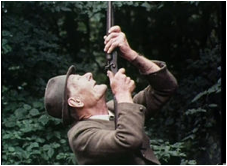 True escapism this summer is to be found with the Page family in Philip Trevelyan‘s 1970 steam-engine idyll-doc. Seventysomething Dad, in suit and cap, and four grown children live off hens, tinker work, and daydreams in a Sussex glade, where they raise puttering to a fine (or folk) art. Like an H.G. Wells–era vision of a fallen future, or a Mayan ruin overgrown and reinhabited, their green and pleasant patch hosts coal-powered traction engines, pipe organs, and philosophizing on the true topography of the moon or the kangaroo’s superiority to the lion as a pet. Trevelyan, who made a string of rural-embed docs, admired the Pages’ natural surrealism and himself ultimately retired to organic farming and custom toolmaking. The seclusion is just as much an effect as a reality, and the resulting world and its garden of metaphors for the artistic pursuit have influenced outsider admirers and experimental filmmakers. Yet, needless to say about four adults penned up with a parent, vexation and wistfulness are also written on the younger faces, and let’s not even start on the close-up of willowy Kath at the bellows as Dad pounds at the organ.
True escapism this summer is to be found with the Page family in Philip Trevelyan‘s 1970 steam-engine idyll-doc. Seventysomething Dad, in suit and cap, and four grown children live off hens, tinker work, and daydreams in a Sussex glade, where they raise puttering to a fine (or folk) art. Like an H.G. Wells–era vision of a fallen future, or a Mayan ruin overgrown and reinhabited, their green and pleasant patch hosts coal-powered traction engines, pipe organs, and philosophizing on the true topography of the moon or the kangaroo’s superiority to the lion as a pet. Trevelyan, who made a string of rural-embed docs, admired the Pages’ natural surrealism and himself ultimately retired to organic farming and custom toolmaking. The seclusion is just as much an effect as a reality, and the resulting world and its garden of metaphors for the artistic pursuit have influenced outsider admirers and experimental filmmakers. Yet, needless to say about four adults penned up with a parent, vexation and wistfulness are also written on the younger faces, and let’s not even start on the close-up of willowy Kath at the bellows as Dad pounds at the organ.
![]()
***BEST NEW OLD RELEASE OF THE WEEK***
The Moon and the Sledgehammer (Anthology Film Archives) — This lost gem from the early 1970s casts quite a hypnotizing spell as it profiles a truly eccentric English family living on an estate in the country. The Pages are about as removed from society (some might say reality?) as a family can be. Director Philip Trevelyan presents their quirky lifestyle with a quiet cinematic charm, capturing the sharp contrast between the quiet, woodsy nature of their surroundings with their loud work on old tractors and machines. The Moon and the Sledgehammer is a lovely lesson in how to turn a potentially exploitative subject into something much more tender and poetic.

Critic’s rating 4/5 stars THE MOON AND THE SLEDGEHAMMER
“It’s a good job the moon’s well up there,” the old man says. “I got room enough to swing a sledgehammer underneath him.” As peculiar as it is hypnotic, Philip Trevelyan’s 1971 oddity documents a bold British family living off the grid in the Sussex woods. On the outskirts of London, the elderly Mr. Page, along with his two sons and daughters, makes do with little. Lacking running water and electricity, their only links to “modern” technology are the steam tractors they repair to make a living and the rifles they use to shoot their next meal. Gripping his camera, Trevelyan steps uncomfortably close to these craftspeople, molding an intimate family portrait that is at once perplexed and awestruck.
The women knit and garden; the men rev their engines; and Mr. Page decries the urban London lifestyle. They seem at first naive about the ways of the world, but Trevelyan captures something poignant in their uncluttered harmony with the land. Birds and bugs swarm the farm. A rotting piano left outdoors sounds eerily beautiful. A kitten dances with the hands of Mr. Page’s son as he fantasizes about the moon, drawing its shape in the soil. Mr. Page scoffs at these imaginative ramblings, less because he’s uninterested in the heavens than because he sees more that’s worth cherishing in his wooded oasis. He may be right—and that’s what makes this bizarre biography so unforgettable.—S. James Snyder
The Best Old Movies on a Big Screen This Week: NYC Repertory Cinema Picks, April 6-12
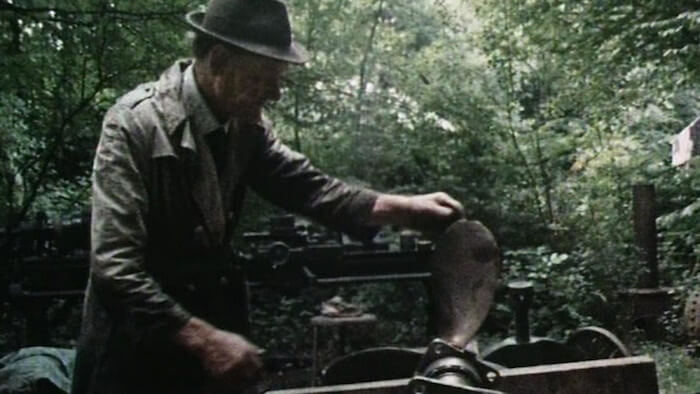
The Moon and the Sledgehammer (1971)
Directed by Philip Trevaylen
In the opening moments of The Moon and the Sledgehammer, the camera pushes aside branches and finds a clearing: the Page family residence, a few miles outside of London. Nobody’s home, so the camera has a look around, peering in for close-ups of the pianos, smithing tools and steam engine components scattered about the lawn, before the elderly Page patriarch emerges from the woods to deliver a ringmaster’s greeting. A tone of wonderment at a found object Trevelyan vérité-style but clearly pieced-together glimpses of Page—a circus clown turned self-sustaining woodsman, tinkerer and pipe organist—and his grown children, two feral gardener girls and two lost-boyish, passionately mumbling engineers, especially handy with old steam engines. Stray moments and pronouncements about sustainable lifestyles and overdependence on petroleum seem prescient—though the Page children are almost closer to the idiosyncratically socialized rural eccentrics in the phonetic dialogue scenes of a Victorian novel than today’s very in-the-know opt-outs. Ultimately this is family portrait, too specific and singular to be anything but a curio first and foremost. As a curio, though, it offers up gorgeously strange images, moments that take no set social rule, technological advance or natural relationship as a given.Mark Asch (April 9, 6:15pm at the Film Society of Lincoln Center’s “Art of the Real,” introduced by filmmaker Ben Rivers)

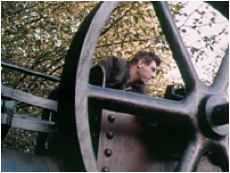
The Moon and the Sledgehammer
by Andrew Schenker
Posted: June 1, 2009

Director(s): Philip Trevelyan. Cast: Mr. Page, Jim Page, Peter Page, Kathy Page, and Nancy Page. Runtime: 65 min. Rating: NR. Year: 1971
Athough the film opens and closes with shots of cars wending their way down a suburban English street, the only vehicles glimpsed during the balance of Philip Trevelyan’s 1971 documentary The Moon and the Sledgehammer are of a considerably less contemporary orientation. That’s because the film’s subjects, the Page family, lead an isolated, defiantly pre-modern (though not pre-industrial) life, subsisting without electricity or running water while confining themselves to their six acres of wooded property south of London. While the women occupy themselves with gardening and embroidery, the men take on intensive mechanical work, rehabilitating an old steam engine, building a boat from scratch, their labor a throwback to an outmoded artisanal tradition that, in concert with the men’s stated philosophies, stands as a corrective to the prevailing curse of “push-button machinery.”
Notwithstanding the family members’ less than perfect articulation and the logical flaws of their arguments, theirs is a life lived philosophically. Confining his focus to the Page property and alternating between wide shots of the family going about their daily business and interview segments shot in uncomfortably tight close-up (picking out the odd pucker of the father’s cheeks when he puffs on a cigarette or the red splotches on one of the women’s faces), Trevelyan captures both the subjects’ obvious eccentricities and their apt musings on the wider world. Introduced reciting a bit of cockney poetry and dressed throughout in a shabby but functional suit, Mr. Page is both the film’s chief philosopher and clown. Possessed of some knowledge of outside society (though he seems unaware of, for example, the moon landing), but little positive regard for its functioning, he opines on the sorry state of the world, the prevalence of pesticides that make outside food inedible and the lack of quality work that results from mass production. Never at a loss for an opinion, the patriarch chimes in on matters of less weighty import as well. In one of the film’s more amusing—though borderline condescending—moments, he discourses at length, at the director’s prompting, on which animals are likely to make good pets (kangaroos, yes; lions and monkeys, no).
Despite his pretense at an objective stance (apart from a single title card, the film features no narration), Trevelyan’s portrait of the family’s lifestyle is chiefly positive. But in the film’s last 10 minutes, we learn that all is not exactly right in paradise. Mr. Page tells the camera that one of his sons is “no good.” Then his children (he has two sons and two daughters) begin to express dissatisfaction with their own lot and reveal to Trevelyan their father’s stubborn and unsupportive character. Watching this sequence, one wonders what impact the introduction of the director’s modern equipment into their isolated lifestyle might have had on the participants, both as a chance to air these pervious unacknowledged grievances and as a potential threat to their mode of existence. But mostly the family seems unfazed by the film crew’s presence and the issue isn’t explored any further. In fact, given the film’s short running time, modest scope and lack of any contextualizing information, that’s far from the only question of interest the filmmaker fails to raise. Still taking into account the very specific parameters of Trevelyan’s project, what we get is finally of considerably more significance than what we don’t.
THE L MAGAZINE
Film Get Your Reps: The Moon and the Sledgehammer
Posted by Mark Asch on Thu, Jun 4, 2009 at 8:32 AM 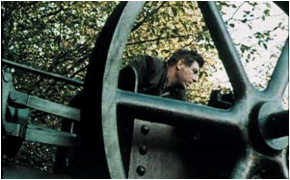
In the opening moments of The Moon and the Sledgehammer (1971), which plays at Anthology Film Archives for a week beginning tomorrow, the camera pushes aside branches and finds a clearing: the page family residence, a few miles outside of London. Nobody’s home, and the camera looks around, peering for close-ups of the pianos, smithing tools and steam engine components scattered about the lawn, before the elderly Page patriarch emerges from the woods to deliver a ringmaster’s greeting. This tone of wonderment at a stumbled-upon object pervades director’s Philip Trevelyan vérité-style but clearly pieced-together glimpses of Page — a circus clown turned self-sustaining woodsman, tinkerer and pipe organist — and his grown children, two feral gardener girls and two lost-boyish, passionately mumbling engineers, especially handy with old steam engines.
Stray moments and pronouncements about sustainable lifestyles and overdependence on petroleum seem prescient, and a family psychodrama, fueled by barest socialization, occasionally bubbles to the surface, but ultimately this family portrait is too specific and singular to be anything but a curio. As a curio, though, it offers up gorgeously strange images, moments that take no set social rule, technological advance or natural relationship as a given.
Tags: The Moon and the Sledgehammer
![]() Arts
Arts
The Week Ahead | June 7 — June 13
By THE NEW YORK TIMES
Published: June 5, 2009 Film
Manohla Dargis 
In 1990 a writer for The Times of London described “THE MOON AND THE SLEDGEHAMMER” as “one of the most original British films of the early 1970s.” Certainly until its recent release on DVD, Philip Trevelyan’s 65-minute 1971 documentary about an off-the-grid family living in a woodland patch some 20 miles from London was one of the lesser-known works of that era. Living with working and nonworking machines, a handful of chickens and a peacock, the Pages — two adult sons, two adult daughters and a father who might be anywhere from 60 to 80 — initially appear to belong to the back-to-the-land movement. They live without electricity and running water, and one son murmurs about the world’s inevitable oil shortage.
The DVD distributor appears eager to stress this utopian angle, as suggested by its description of the family: “They are in control of their world in a way that we can never be in control of ours.” That’s one way of putting it. Frankly, the images of the Pages puttering about brought to mind Frederick Wiseman’s “Titicut Follies” (1967) and Albert and David Maysles’s “Grey Gardens” (1975), classics of direct cinema in which the agency of the people in front of the camera remains an open question. The standard critical descriptions of the Pages as dotty, eccentric and quirky seem too restrained for these poignantly isolated souls. “The Moon and the Sledgehammer” is showing with three British shorts: Andrew Kotting and Nick Gordon Smith’s “Diddykoy”; Mr. Kotting’s “Jaunt”; and Ben Rivers’s “This Is My Land.” 7 p.m. and 9 p.m., through Thursday, Anthology Film Archives, 32 Second Avenue, at Second Street, East Village ,





